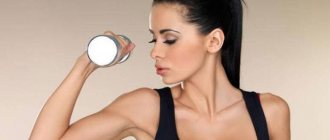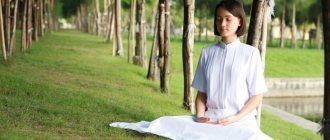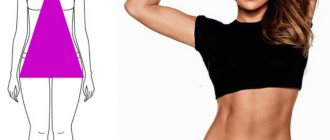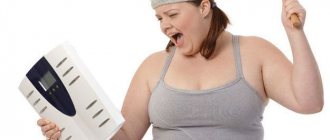Around 1490, the great Italian scientist, artist, and sculptor Leonardo da Vinci drew his famous drawing “The Vitruvian Man.” This design is often used as a symbol of the symmetry of the human body. It depicts the figure of a naked man in two superimposed positions: with arms and legs spread to the sides, inscribed in a circle; with arms apart and legs brought together, inscribed in a square. The drawing and its explanations are sometimes called canonical proportions. The significance of this drawing is difficult to overestimate. After all, proportions are a means of creating a harmonious image not only for architects, artists, designers, but also for clothing designers.
Leonardo da Vinci's theory of proportionation
The meaning of the “Vitruvian Man” is that only the ideal proportions of the human body make it possible to fit a position with arms and legs apart into a circle, and with arms and legs apart into a square. However, the theory of proportionation itself (Leonardo da Vinci only embodied it in a drawing) was created by another Roman scientist and architect - Marcus Vitruvius Pollio. Later, this theory became widespread in fine arts and architecture.
According to this theory, the following ratios are characteristic of the ideal proportions of the human body:
- » the length from the tip of the longest to the lowest base of the four fingers is equal to the palm
- » a foot is equal to four palms
- » a cubit is equal to six palms
- » the height of a person is four cubits (and accordingly 24 hands)
- "A step is equal to four cubits
- » the span of human arms is equal to its height
- » the distance from the hairline to the chin is 1/10 of its height
- » the distance from the top of the head to the chin is 1/8 of its height
- » the distance from the top of the head to the nipples is 1/4 of its height
- » maximum shoulder width is 1/4 of its height
- » the distance from the elbow to the tip of the hand is 1/4 of its height
- » the distance from the elbow to the armpit is 1/8 of its height
- » arm length is 2/5 of its height
- » the distance from the chin to the nose is 1/3 of the length of his face
- » the distance from the hairline to the eyebrows is 1/3 of the length of his face
- » ear length 1/3 face length
- » Proportionality calculator
- » Grace Calculator
- » body mass index
- » Fitness calculator
Anthropometric characteristics of the human body
Anthropometric characteristics of the human body
Topic 2.1. Brief information about the structure of the human figure
Total morphological dimensional characteristics.
Total dimensional characteristics include the largest anthropometric characteristics:
body length (height), chest girth (perimeter), body weight.
— Height:
The body reaches its final length by 16-17 years. The average height for women is 154cm (157-158cm in Russia), for men – 165cm. During the day, growth changes, by the evening it decreases by 1.5-3 cm. Stable until 40-45 years, after which body length decreases by 0.5 cm every 5 years, and then by 0.7 cm every 5 years. Height ranges from 134 cm to 182 cm. Body length less than 125 cm and more than 2 m is a pathology.
— Bust
: stabilizes by 18-20 years, only increases with age. After 60 years it decreases. The norm is from 72 cm to 136 cm.
— Body mass.
In Russia, the average body weight is 56 kg, in Europe - 64 kg, weight less than 45 kg and more than 90 kg is considered pathological. Constant weight remains at the age of 25 to 40 years, from 40 to 55 years there is an increase of 1 kg every 5 years, and after 60 years, due to dehydration of the body, body weight decreases.
By studying and analyzing the individual figure of a person, we can characterize the size and shape of individual parts of his body: torso, neck, upper and lower limbs.
The torso is the largest part of the body, which in its shape and size is determined by the shape of the chest, the size and shape of the shoulder (shoulder slope), mammary glands and back. The lower part of the body is characterized by the shape of the abdomen, the shape of the gluteal muscles and the lateral surface of the thigh.
2.2. Proportions of the human body.
The proportions of the human body are the ratios of the sizes of individual parts of the body to each other and to the entire figure as a whole (height).
Sometimes proportions are expressed as percentages. There are 3 types of proportions, two of which are disproportionate figures.
Dolichomorphic
type
: characterized by long limbs, with a relatively short and narrow body, tall stature and a small head (the head fits 8.5 times the height), most often these are tall and stooped people.
Brachymorphic type
: characterized by short limbs, with a relatively wide and long body, short stature and a large head. People of short stature may be overweight and have a crooked posture; the head can be folded 7.5 times.
Mesomorphic type
: intermediate type, conditionally proportional figure, head fits 8 times height.
2.3. Posture.
Posture is a characteristic of the balanced position of the human body in a calm state.
Posture is understood as the individual characteristics of the body configuration in a natural (calm) vertical state, requiring minimal expenditure of muscle energy to maintain the body in balance.
There are three types of figures depending on posture. The leading feature that determines posture is the shape of the spine. Attention is paid to the degree of curvature of the spine in the thoracic and lumbar regions.
Conditionally typical figure – equilibrium type
: characterized by an equal degree of curvature of the lumbar and thoracic spine.
Stooped figure - kyphotic
: characterized by a large curvature of the thoracic spine and a small curvature of the lumbar spine.
Bent figure – lordotic
: small thoracic curve and large lumbar curve.
Posture, from a morphological point of view, characterizes the external shape of the body as a whole, so it is determined by various factors: the position of the head and hands and feet, the shape of the spine, chest, anterior abdominal wall and pelvic tilt. Externally, the figures can be described as follows:
A conditionally proportional figure (according to posture) is taken to be a figure in which the body is not tilted either forward or backward, the chest, buttocks, and stomach protrude slightly.
Stooped (slanted figure): a figure in which the body is tilted forward, the back to the waist is longer than the typical one, and the front is shorter. Wide rounded back, narrow sunken chest, flat buttocks, protruding belly.
Bent - the body is tilted back, the length of the front to the waist is longer than the standard one, and the length of the back is shorter, a wide open chest, a narrow back, protruding buttocks.
Figure 3. Figures with varying degrees of bending in the thoracic and lumbar spine.
Posture is characterized by a number of projection features:
1. PC - body position: this is the distance from the cervical point (7th cervical vertebra) to the vertical plane touching the most protruding parts of the shoulder blades.
Stooped – 8.2±1cm;
Equilibrium – 6.2±1cm;
Inflected – 4.2±1cm.
2. Vp - shoulder height: the vertical projection measurement is defined as the difference in the height of the neck and shoulder points.
Low-shouldered figure – 7.4±0.75
Conditionally proportional – 5.9±0.75
High-shouldered figure – 4.4±0.75
3. ГтI – waist depth: horizontal distance from the vertical plane touching the most protruding points of the shoulder blades to a ruler applied horizontally along the back at the level of the waist line.
ГтII – horizontal distance from the vertical plane touching the most protruding points of the buttocks to the ruler at the waist line. GtII>GtI
2.4. Body type .
For a specialist engaged in the manufacture of clothing, it is important to be able to give an accurate description of the characteristics that determine the body type. This will help you take a differentiated approach to choosing a model for figures with different structures.
Body type
– the constitution of the human body, characterized by a complex of structural features. Depends on the degree of development of muscles and fat deposits in individual areas of the body, the shape and size of the skeleton, and age. The physique is judged by the shape of the neck, chest, abdomen, back, upper and lower extremities.
The degree of muscle development is determined in the shoulder girdle, chest, back, arms and legs. For each area, weak, medium, strong (two intermediate ones - medium-weak, medium-strong) muscle development are distinguished.
The degree of development of fat deposits, or subcutaneous fat, is characterized by the size of fat folds on the inside of the shoulders and forearms, thighs, legs, under the shoulder blades, on the chest and abdomen. The degree of development of fat deposits can be weak, moderate and abundant.
With weak fat deposits, the relief of bones - shoulder blades, collarbones, wrist joints, knees, feet - is clearly visible under the skin. With an average degree of development of fatty deposits, the bone relief is poorly expressed. Abundant fat deposits are considered to be the roundness of all contours of the body, the smoothed relief of the shoulder girdle and joints of the limbs due to the strong development of subcutaneous fatty tissue.
A change in the degree of development of muscles and fat deposits entails a change in the shape of the body, namely: neck, chest, abdomen, back, upper and lower extremities.
Body types of female figures (according to Shkerli)
Body types of female figures are characterized mainly by the presence of fat deposits in various parts of the body. According to B. Shkerli’s classification, three main and one additional groups are distinguished:
Group I
: Women
with an even distribution of body fat
. There are 3 types:
L – thin type, it has poorly developed muscles, a low degree of fat deposits. – (prototype “Diana” - goddess of the hunt, ancient Greek mythology)
N – normal type: average degree of development of muscles and fat deposits. (prototype – “Aphrodite”)
R – Rubens type (prototype – “Venus” or women from Rubens’ paintings) – figures with abundant fat deposits.
Group II
:
with uneven fat deposits
:
S – upper type, characterized by abundant fat deposits in the upper part of the figure (neck, chest, abdomen, arms.)
I – lower type, characterized by abundant fat deposits in the lower part of the body (buttocks, thighs, lower legs, lower abdomen)
Group III:
with uneven fat deposits
.
Trunk - Tr, fat deposits are concentrated on the trunk.
The extreme type is Ex, fatty deposits on the extremities.
IY group
–
additional: with uneven fat deposits in certain areas of the body:
Breast type – M, Developed mammary glands,
Thigh – T, fat deposits predominate in the thigh area.
Topic 3. Size typology of the adult and child population
Anthropology –
the science of the origin and evolution of human physical organization.
Morphology
- the science of the laws of human growth, of variations in his physical structure.
Anthropometry –
research methods in anthropology, a system of measuring the human body and its parts in statics and dynamics.
3.1. Anthropometric measurements of the population
.
Population measurements for the clothing industry began in the 1930s. But the results of these measurements were not processed.
The largest population measurements were carried out from 1956 to 1965. in 80 regions of our country. More than a million people were examined. Based on these measurements, a size typology and scales of typical sizes and heights have been developed. This work was carried out by the Research Institute of Moscow State University, TsNIISHP, the Plekhanov Moscow Institute of National Economy and the All-Union House of Clothing Models (ODMO).
In 1960-70 New research was carried out on anthropological standardization for clothing design in our country and in the CMEA member countries.
As a result, CMEA recommendations were created for the standardization of the adult and child population RS3137-71g. "Cloth. Typical figures of women and men and their dimensional characteristics for clothing design"
Based on this document, the USSR developed state standards for measuring typical figures GOST 17522-72 “Typical figures of women. Dimensional characteristics for clothing design." GOST includes 509 types of female figures and gives their percentage distribution in the USSR (mostly we have 253 types).
Based on this GOST, OST 17-326-74 was developed, and then a new OST 17-326-81 “Sewing, knitted, fur products. Typical figures of women. Dimensional characteristics for clothing design." Contains 148 types of shapes.
OST sets
:
- Typical figures of women and their classification by height, chest circumference, weight and age groups.
- Name of the main anthropometric points and dimensional characteristics, their symbols and method of determination.
- Absolute values of dimensional characteristics of typical female figures.
3. 2. Dimensional typology of figures
The typical figure of a woman is determined by the following dimensional characteristics
: height, chest girth III, hip girth
.
The entire female and male population is divided into 3 age groups:
— younger age (18-29 years);
- middle age (30-44 years)
- eldest - 45 years and above.
This OST presents typical female figures, height from 146 to 176 cm with an interval of 6 cm.
Height: 146 where 6cm is the interval of indifference – the gap, inside
152 which the consumer does not feel
158 +- 3 absences of intermediate size.
164
170
176
Typical figures are represented by chest girth from 84 – 135 cm with an interval of 4 cm.
84 100 116
88±2 104 120
92 108 124
96 112 128 onwards
Depending on the difference in hip girth and chest girth, typical female figures are grouped into 4 full groups.
| Bust , cm | Hip girth | |||
| I completeness (4cm difference) | II completeness (difference 8cm) | III completeness (difference 12cm) | IY completeness (difference 16cm) | |
| 84 | 88 | 92 | 96 | 100 |
| 88 | 92 | 96 | 100 | 104 |
| 92 | 96 | 100 | 104 | 108 |
| 96 | 100 | 104 | 108 | 112 |
| 100 | 104 | 108 | 112 | 116 |
| 104 | 108 | 112 | 116 | 120 |
| 108 | 112 | 116 | 120 | 124 |
| 112 | 116 | 120 | 124 | 128 |
| 116 | ||||
The complete group is determined by Ob –Og III = D,
where D= 2-4cm-6 – I full gr.; 6- 8cm-10– II full gr.; 10-12cm -14 – III full gr.; 14-16cm-18 is the IY complete group.
Thus, the typical figure of a woman is written down:
164 – 88 –96 170 – 96 – 108 158 – 92 – 98
164 – 92 – 108 152 – 84 – 92 176 – 112 – 120
158 – 108 – 116 146 – 84 – 88
Task for consolidation
:
For each size (listed above), determine its complete group.
3.3. Anthropometric points.
Anthropology deals with the collection and systematization of information about the shapes and sizes of the human body. These parameters are judged by measurements based on anthropometric points.
Anthropometric points correspond to clearly defined skeletal structures or well-defined soft tissue boundaries.
Anthropometric points, their name and position.
A
– apical – the highest point of the crown
b
– cervical – 7th cervical vertebra.
V
– the point of the base of the neck – the intersection of the neck girth line with a vertical plane cutting the shoulder in half.
G
– clavicular – the highest point of the sternal end of the clavicle.
d
– upper sternal – center of the jugular notch.
e
– midsternal – in the middle of the sternum at the level of the 4th rib (the beginning of the mammary glands).
and
– humeral acromial
h
– humeral – the end point of the shoulder.
And
– radial – the upper point of the head of the radial bone.
To
– nipple – protruding point of the mammary glands.
l*
– femoral point – the most protruding point of the lateral surface of the thigh.
l
– spinoiliac – the most protruding point of the upper anterior iliac spine.
m
– patella – center of the kneecap.
n
– anterior angle of the armpit – the highest point of the arc formed by the anterior opening of the armpit with the arm lowered.
O
– posterior angle of the axilla
P
– gluteal – the most protruding point of the buttocks.
R
– waist point – the point of height of the waist line along the lateral surface of the body.
Anthropometric points on the human figure are used to determine the position of the measuring tape when measuring the figure.
The method for determining points is given in OST 17.325 - 86 and 17.326 -81, using 13 anthropometric points. Three points (d, g, l), measurements through which are not used when designing clothing, are not included in the industry standard.
The so-called structural belts, which are important in modeling and designing clothing, pass through the anthropometric points.
3.4.Constructive belts
When studying the human figure, the main large forms from which the figure is built are identified: head, chest, pelvic area and limbs.
There are also structural belts on the human figure, which serve as supporting surfaces of clothing on one or another shape of the figure.
The need to highlight such constructive belts is due to the fact that clothing is characterized by one or another degree of fit of the figure in its various parts
Constructive belts are a conventional circular line and its horizontal projection, mentally drawn at the levels of the figure that are fundamentally important for design.
Structural belts, their name and position
.
1. cephalic - runs along the head along the protruding frontal tubercles and occipital bone. This line is the dimensional line of the head and the basis for creating hats and hoods
2. cervical - at the base of the neck. In this area there is a neckline, and it is the main one when modeling collars of various types.
3. shoulder – along the lower points of the collarbone. The shoulder girdle determines the width and shape of clothing, taking into account the shape of the shoulders - narrow or wide, sloping or straight.
4. chest - along the protruding points of the chest. It is of great importance in determining the degree of volume and width of the product in the chest area, the location of the ends of the upper dart, as well as the place of horizontal division in this part.
5. waist - along the waist line, determines the degree of volume, the width of the product along the waist line and its level and is the place of the main division of the figure horizontally.
6. hip - passes through the entire figure along the protruding points of the hips, defining the widest part of the female figure. The volume of clothing should be no less than the size of this belt.
The leg belts are located parallel to one another from the pubic fusion to the point of articulation of the lower leg with the foot; they determine the length and width of trousers, as well as the length of dresses, skirts, coats:
- thigh belts - along the thigh of the leg to the kneecap
- knee girdle - along the kneecap, at the junction of the thigh and lower leg
- at ankle level
The constructive arm belts are located parallel to one another from the armpit to the wrist and determine the volume, width and length of the sleeves of clothing:
- on the line where the arm meets the body, measuring the shoulder circumference;
11. ulnar - along the elbow, at the junction of the arm and forearm. It determines the location of the elbow dart on the sleeve;
12. carpal - at the narrowest point of the wrist, at the junction of the forearm and the hand.
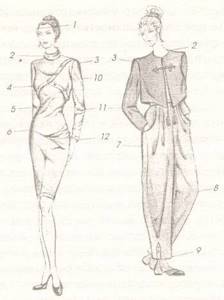
The main structural belts of clothing:
Shoulder, waist and hip.
They pass along the supporting surfaces of the figure.
Supporting surfaces are the areas of contact between clothing and the human body.
Along with horizontal structural belts, there are also vertical ones, running in the middle of the front and back surfaces of the body, along the lateral lines, through the protruding point of the chest and also determining the width of the base of the neck at the back.
Structural belts determine the most functionally justified locations of constructive and decorative lines, for example, the upper or lower edge of the product, yokes, reliefs, and decorative details.
The topic is vast
Golden ratio theory
However, the theory of proportionation of Marcus Vitruvius Pollio arose much later than the theory of the “golden section” or “divine proportion”. It is generally accepted that objects containing the “golden ratio” are perceived by people as the most harmonious. The Pyramid of Cheops in Egypt, the Parthenon in Athens, the Notredame de Paris Cathedral, the paintings of Leonardo da Vinci “Mona Lisa” and “The Last Supper”, Botticelli’s “Venus”, Raphael’s “School of Athens” and many, many other objects were created according to the “golden” principle sections".
In 1855, the German researcher of the golden ratio, Professor Zeising, published his work “Aesthetic Studies”. He measured about 2,000 human bodies and came to the conclusion that the golden ratio is universal. The division of the body by the navel point is the most important indicator of the golden ratio. The proportions of the male body fluctuate within the average ratio of 13: 8 = 1.625 and are somewhat closer to the golden ratio than the proportions of the female body, for which the average proportion is expressed in the ratio 8: 5 = 1.6. In a newborn, the proportion is 1:1; by the age of 13 it is 1.6, and by the age of 21 it is equal to that of a man. The proportions of the golden ratio also appear in relation to other parts of the body - the length of the shoulder, forearm and hand, hand and fingers, etc.
- » Types of proportions in clothing: similar, harmonious, contrasting
- » Normal height, weight and leg length
- » How to determine your proportions: standards
- »What types of female figures are there?
- » How to determine your body type? TEST.
The concept of perfection among the ancient Greeks
If we take ancient statues, their sizes are closer to natural parameters, which is explained by the rule of the “Golden Section”, derived by the ancient scientist Pythagoras. And, based on it, perfection should be determined by the following proportions for both sexes:
- waist size should be twice the neck circumference;
- in turn, the neck is twice the circumference of the wrist;
- shoulder width should not exceed 1/4 of a person’s height;
- The size of the forearm and foot (their length) should ideally be equal.
If something doesn’t add up, it means the figure is not perfect. But seriously, since every person is unique, we shouldn't be so strict about perfection.
Today, beauty is determined, first of all, by health - if a person is healthy, he will always have excellent skin condition, a blooming appearance and the absence of excess fat.




